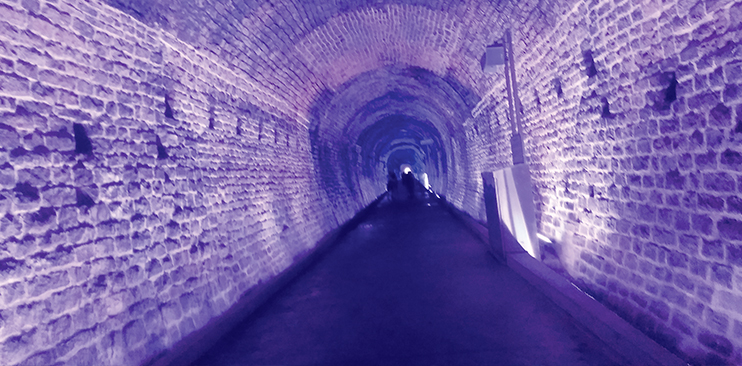Our main departure points would be from Prescott or Brockville.
These dives were typically low visibility with a high current and varying degrees of hazards. That aside, it was the history of what we descended to that was always intriguing. Most of the wrecks sunk in the 1800s and onwards. I also liked the fact that this was more of technical diving which helped increase my skill level and sensibility under harsher conditions.
This summer we would have a set of dives leaving from Brockville and a set from Rockport. While waiting for Hubert and other divers one day, I wheeled through the Canada’s first railway tunnel in Brockville. The tunnel was built between 1854 and 1860 to allow the fledging Brockville and Ottawa Railway to connect the Brockville industrial waterfront area to the outlying areas lying between the St. Lawrence and Ottawa rivers. The way they have transformed this tunnel is an experience in itself. While music is playing, a varying array of colour changes take place from one end to the other. It’s a photographer’s paradise and the squeal of kids echoes through this impressive piece of history.
Once everyone arrived, we left the dock to see the wreck of the Dalriada. This would be one of my most challenging dives to date. My dive partner Kat and I would descend from the surface down 20 feet to a rock ledge. From there we would use a line that went from the rock ledge to the wreck below at approximately 70 feet. The factors in this dive included an extremely high current and low visibility due to an overcast sky above. When the wreck came into view at the stern, its props were massive. We would make our way into the wreck with the current remaining strong. We soon realized that my arms were not strong enough to continue penetrating the wreck, so we converted to a drift dive. Upon ascent to the surface we were greeted by a torrential downpour. It’s never easy on the St. Lawrence.
I would do a second set of dives departing from Rockport on September 6 and 7. Rockport is located off the 1000 Island parkway east of Gananoque. It has been a port since the late 1700s. For decades boats were built in Rockport; from small wooden St. Lawrence skiffs to large tour boats used on the St. Lawrence River, in Canada’s capital city Ottawa on the Rideau and Ottawa Rivers, and as far away as Banff National Park in Alberta. The area is still famous for boat building, as the industry is producing ice boats that make winter travel to local island homes possible. It now hosts tour busses full of travellers that will take one of the many available tour boats.
I arrived on Thursday the 6th to a bright sky and the river looked calm. The interesting part of the dives I would be part of over the next couple of days would be that they were in the U.S waters of the St. Lawrence River. That would mean clearing American customs at Boldt Castle located on Heart Island before going to our wreck site. The other sad factor was that a boat had capsized in the area and OPP boats, divers and helicopters were scouring the area for a missing 11-year-old boy. When we departed the OPP dive boats had moved upriver. I privately paid my respects as we made our way to the castle. During that ride, we would pass the shortest bridge between Canada and the United States joining two islands. I would also be seeing Boldt Castle from a different perspective this time.
During the previous summer of diving I had treated myself to a helicopter flight over the 1000 Islands which included seeing the castle from the air. George Boldt managed the Waldorf Astoria in New York City as well as the Bellevue Stratford in Philadelphia. The family spent many summers on the island and the quaint cottage expanded over the years. In 1900, George began a project to build one of the largest private homes in the U.S. He hired the architectural firm G. W. & W. D. Hewitt and hundreds of workers to build a six-story ‘castle’ as a present to his wife. There are also four other masonry structures on the island. The construction of Boldt Castle ceased abruptly in early 1904 after the death of Boldt’s wife, Louise Kehrer Boldt. George Boldt never returned to Heart Island, leaving this structure for 73 years as a monument of his love.
The 1000 Islands Bridge Authority acquired Heart Island and the nearby yacht house in 1977 for one dollar. Under the agreement all revenues obtained from the castle operation would be applied towards its restoration. This would allow for the preservation of the island and for the enjoyment of future generations. In the two decades after acquiring the property, the 1000 Islands Bridge Authority spent some $15 million for restoration and improvements and work continues annually. As we got closer to the mammoth structure it was clear this gift was something to behold.
After clearing customs, we would make our way to the SS Keystorm, a steel freighter that sank in 1912 after hitting Scotch Island shoal. The captain and first mate were found guilty of negligence after the sinking. It is one of Hubert’s and many divers favourite wrecks and is one of Ontario’s premier wreck sites. Her stern rests 112 feet below the surface and her bow is about 20 feet from the surface. The other interesting feature was the air bubble located about 25 feet from the surface that has been intact since she sank in 1912.
After a relaxing boat ride and gearing up we arrived and tied off to the mooring line. Not far from us was Singer Castle on Dark Island. It had been known as the Dark Island Castle for a number of years. It was built from 1903-05 around the same time as Boldt Castle for Frederick Gilbert Bourne, president of the Singer Manufacturing Company. It is now used for private functions and has many old Singer sewing machines on display.
As I closed up my dry suit the nagging question remained, would my legs be dry after my dive. I had ankle valves installed to prevent inversion while diving. It can occur if air gets trapped in the feet of the dry suit. You could invert with feet pointing to the surface and be in an uncontrollable ascent, which is very dangerous. Hubert had a friend skilled in gear repair look at it. He determined that the valves were incorrectly installed and he reinstalled them following the manufacturer’s guidelines.
Once down on the deck of the Helen C with gear checked and my dive partner Hubert in the water we descended to the Keystorm. We would spend time exploring the inner sanctums of this freighter and visit her air pocket. The current was not strong so navigation was easier. Once back on board the moment of truth would be revealed, would my legs be dry? As I peeled off the dry suit I let out a holler because my legs were dry! Hubert and I would wait for the other divers, including a diver who was blind, to descend on the America and I would phone Norm, my new hero with the good news of his repair.
On the way back to Rockport, Rhiannon Rollings who was one of Hubert’s assistants explained the fascinating history about the area. Hay Island is an island where hay was grown for horses used in the American Civil War and as a landing strip for pilots training during the World War eras. Thwartway Island housed WW1 soldiers suffering from PTSD and effects of mustard gas in a rehab centre that was built there. Death Dealer Island was a stronghold for the smuggling trade. Today the presence of Canadian and U.S. customs police boats is a prominent sight on these waters due to the smuggling trade. Then there is the 1000 Islands Park of which approximately 100 islands are kept as no access environmental stewardship sites. This region, the Frontenac Axis, connects the Canadian Shield from Algonquin Park in Ontario to the Adirondack Mountains in New York. Smuggling of booze, butter and horses would start at the base of Horse Thief Bay road in Rockport. Everything was shuttled over a series of islands to the U.S. mainland.
When we arrived back in Rockport our captain Vince would be the only person allowed to leave the boat. There was a phone that was connected to U.S. customs on Heart Island and once he announced we had landed on Canadian soil we were allowed to leave the dive boat.
The next day was another stellar day and we would follow the same procedure to the Keystorm. With my new-found confidence of my dry suit I would be diving with Rhiannon. We had another relaxing dive on the Keystorm with dry legs. We would enjoy the passing of a freighter between us and Singer Island during our safety interval before we would descend on the America.
The America was a four-legged barge that was used to dynamite the channel to make navigation safer for the freighters passing Singer (Dark) Island. When it sank in 1932, it flipped upside down after a half ton of dynamite exploded on her deck, so the legs as well as twin props are now the highest points of that wreck. We would moor to a large concrete block located a distance from the shipping channel. Once in the water we would follow a line down to the large anchor chain and follow the chain to the wreck. This procedure would keep us at a depth and out of harm’s way if a freighter passed over us. We explored the wreck and followed the chain back to our ascent line. Once on board we did the same procedure to gain access on Canadian soil.
It was a fun two days and I always marvel at the history the river holds. I know in years to come I will be descending in her waters and learning more about this mighty river.






